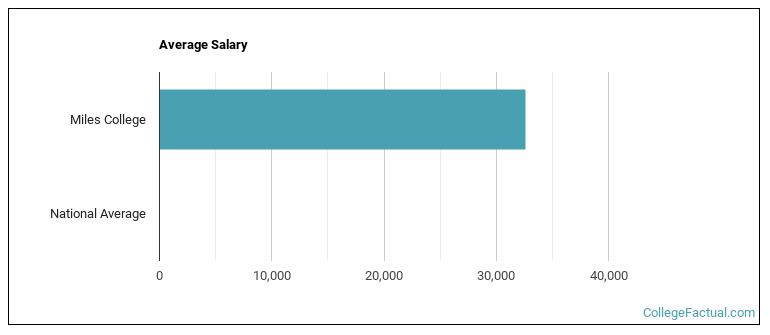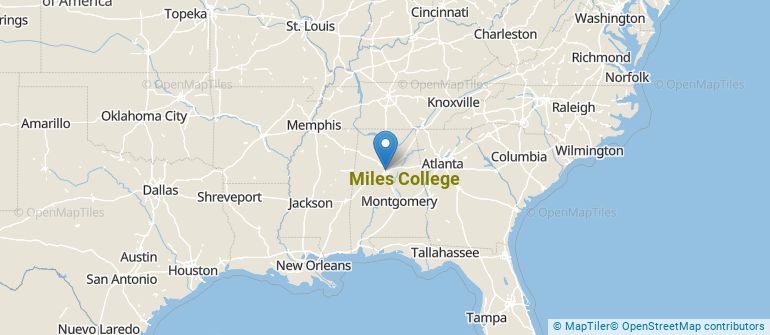 by our College Data Analytics Team
by our College Data Analytics TeamExplore the best ranked schools for the programs you are most interested in.
Miles College was not ranked in College Factual's 2025 Best Overall Colleges report. This could be for a number of reasons, including lack of data.
Miles College has an open admissions policy, so you should not have much trouble being accepted by the school. Still, it is important to fill out the application completely and submit any requested materials, which may include proof that you have a high school diploma or the equivalent.
The student to faculty ratio at Miles College is about average at 14 to 1. This ratio is often used to gauge how many students might be in an average class and how much time professors will have to spend with their students on an individual level. The national average for this metric is 15 to 1.
When estimating how much access students will have to their teachers, some people like to look at what percentage of faculty members are full time. This is because part-time teachers may not have as much time to spend on campus as their full-time counterparts.
The full-time faculty percentage at Miles College is 53%. This is higher than the national average of 47%.
The freshmen retention rate is a sign of how many full-time students like a college or university well enough to come back for their sophomore year. At Miles College this rate is 57%, which is a bit lower than the national average of 68%.
The on-time graduation rate is the percent of first-time, full time students who obtain their bachelor's degree in four years or less. This rate is 14% for first-time, full-time students at Miles College, which is lower than the national rate of 33.3%.
Find out more about the retention and graduation rates at Miles College.
During the 2017-2018 academic year, there were 1,440 undergraduates at Miles College with 1,354 being full-time and 86 being part-time.
| $0-30 K | $30K-48K | $48-75 | $75-110K | $110K + |
|---|---|---|---|---|
| $12,521 | $12,843 | $14,950 | $17,279 | $16,837 |
The net price is calculated by adding tuition, room, board and other costs and subtracting financial aid.Note that the net price is typically less than the published for a school. For more information on the sticker price of Miles College, see our tuition and fees and room and board pages.
While almost two-thirds of students nationwide take out loans to pay for college, the percentage may be quite different for the school you plan on attending. At Miles College, approximately 59% of students took out student loans averaging $3,629 a year. That adds up to $14,516 over four years for those students.

Get more details about the location of Miles College.

Contact details for Miles College are given below.
| Contact Details | |
|---|---|
| Address: | 5500 Myron Massey Blvd, Fairfield, AL 35064-2621 |
| Phone: | 205-929-1000 |
| Website: | https://www.miles.edu/ |
| Most Popular Majors | Bachelor’s Degrees | Average Salary of Graduates |
|---|---|---|
| Business Administration & Management | 44 | NA |
| Criminal Justice & Corrections | 34 | NA |
| General Biology | 19 | NA |
| Social Work | 19 | NA |
| Communication & Journalism (Other) | 12 | NA |
| Music | 10 | NA |
| Computer Systems Networking | 9 | NA |
| Human Development & Family Studies | 9 | NA |
| Political Science & Government | 9 | NA |
| Accounting | 8 | NA |
Online courses area a great option for busy, working students as well as for those who have scheduling conflicts and want to study on their own time. As time goes by, expect to see more and more online learning options become available.
In 2022-2023, 204 students took at least one online class at Miles College. This is the same number of students who took online classes the previous year.
| Year | Took at Least One Online Class | Took All Classes Online |
|---|---|---|
| 2022-2023 | 204 | 109 |
| 2021-2022 | 204 | 113 |
| 2020-2021 | 128 | 71 |
| 2018-2019 | 81 | 49 |
If you’re considering Miles College, here are some more schools you may be interested in knowing more about.
Curious on how these schools stack up against Miles College? Pit them head to head with College Combat, our free interactive tool that lets you compare college on the features that matter most to you!
Footnotes
*The racial-ethnic minorities count is calculated by taking the total number of students and subtracting white students, international students, and students whose race/ethnicity was unknown. This number is then divided by the total number of students at the school to obtain the racial-ethnic minorities percentage.
References
More about our data sources and methodologies.